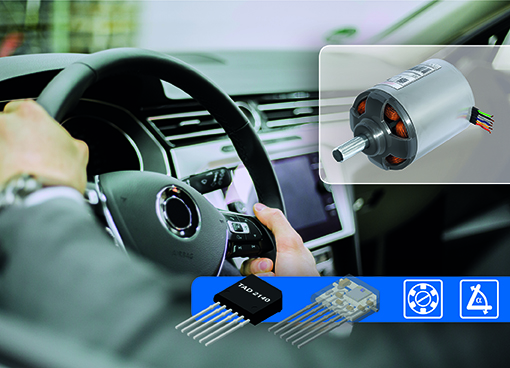TDK Corporation (TSE:6762) is expanding its portfolio of TMR angle sensors with the TAD2140 type in a TO-6 package for automotive and industrial applications. The new sensor provides an innovative system-in-package solution for PCB-less applications. It includes two full TMR bridges, a dedicated ASIC for signal conditioning and integrated passive components. Like all of TDK’s TMR sensors, the TAD2140 features an angle accuracy of ±0.2 °, achieving the world’s smallest angle error of only ±0.05 ° at room temperature. The sensors are capable of contactless sensing from 0 ° to 360 ° over a temperature range of −40 °C to +150 °C. The sensor’s fast response, high angular accuracy, and advanced compensation algorithms make it ideal for the optimization of motor control applications such as BLDC motor commutation. Moreover, thanks to its small package size, the sensor is perfectly suited for applications with limited available space, such as steering motor commutation. Samples will be available from the third quarter of 2018. Start of production is planned for the third quarter of 2019.
TDK will present the new TAD2140 sensor from June 26 to 28, 2018 at the Sensor+Test exhibition in Nuremberg, Germany, at booth 204 in hall 1 and at the same time at the Sensors Expo in San Jose, California, at booth 416.
The TAD2140 comes in a new TO-6 package that integrates six capacitors and one resistor. The sensor can be welded or soldered directly onto a package lead, a connector or a terminal, eliminating the need for a PCB, thus reducing total system size and cost. Furthermore, by using fewer external components and lowering the number of solder joints, thus improving the long-term reliability of the overall system.
The TAD2140 uses an embedded DSP from ICsense, an ASIC design specialist that TDK acquired in March 2017. Thanks to the integrated static and dynamic compensation functions of the ASIC, design-in effort is considerably reduced. The sensor can compensate any drifts of gain, offset or orthogonality as well as mechanical non-idealities like magnet tilt or displacement. In addition, the implemented algorithms allow higher assembly tolerances of mechanical components or increase of the system performance with existing solutions. The ASIC provides several digital outputs such as Hall emulation (UVW), encoder (ENC), pulse-width modulation (PWM), and SENT on two interfaces simultaneously. Furthermore, its various internal diagnostic features make it suitable for demanding automotive applications where functional safety is required (ASIL B rating).



















